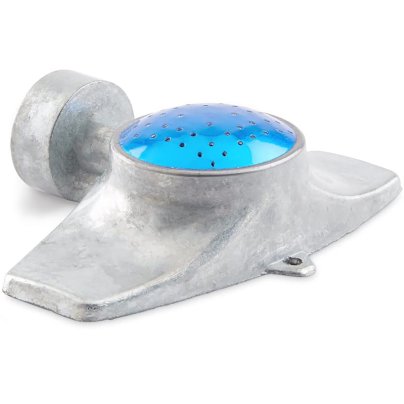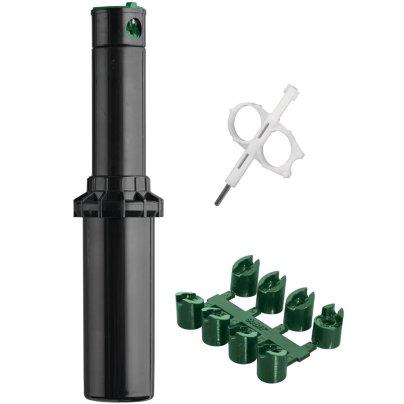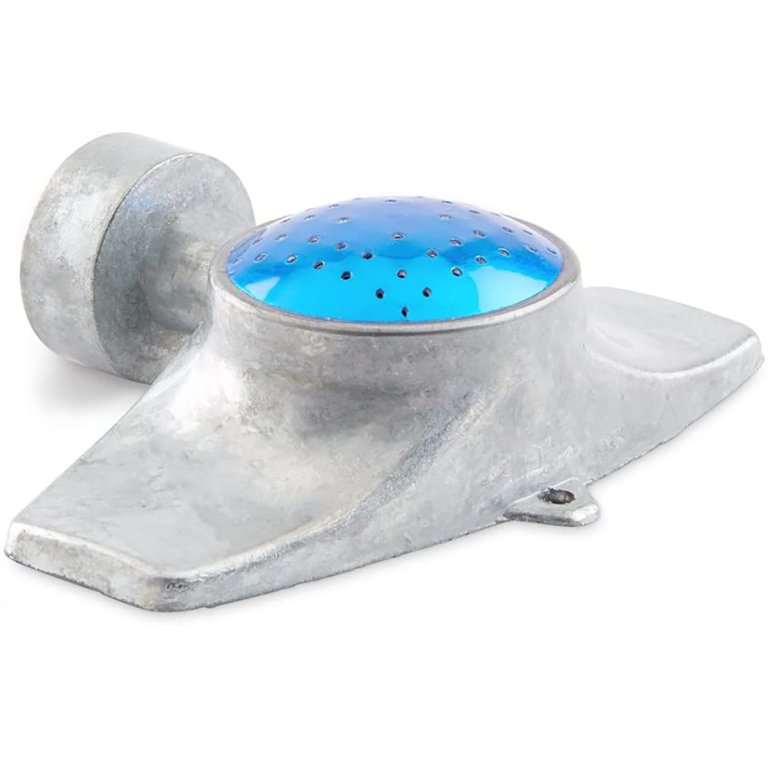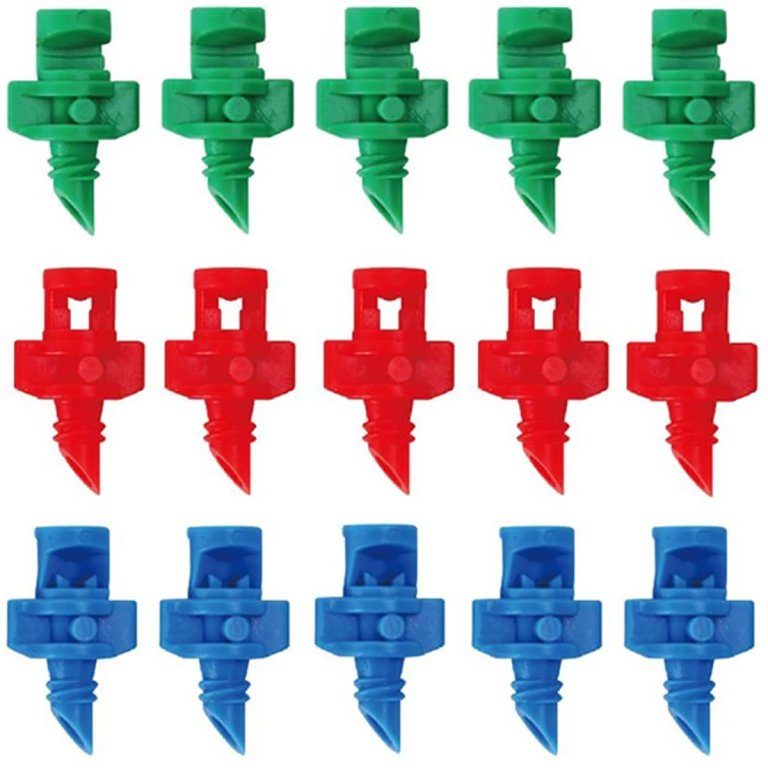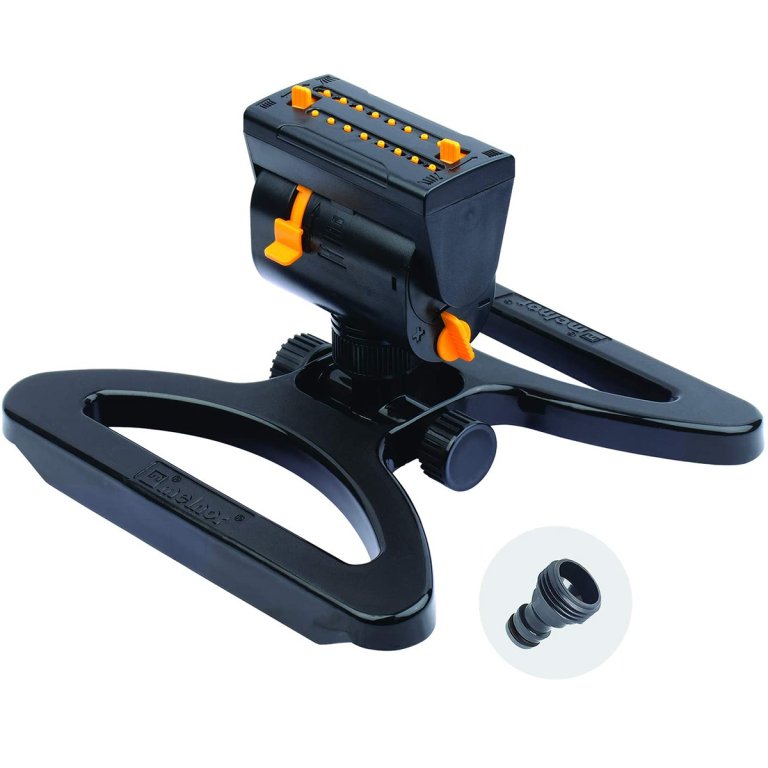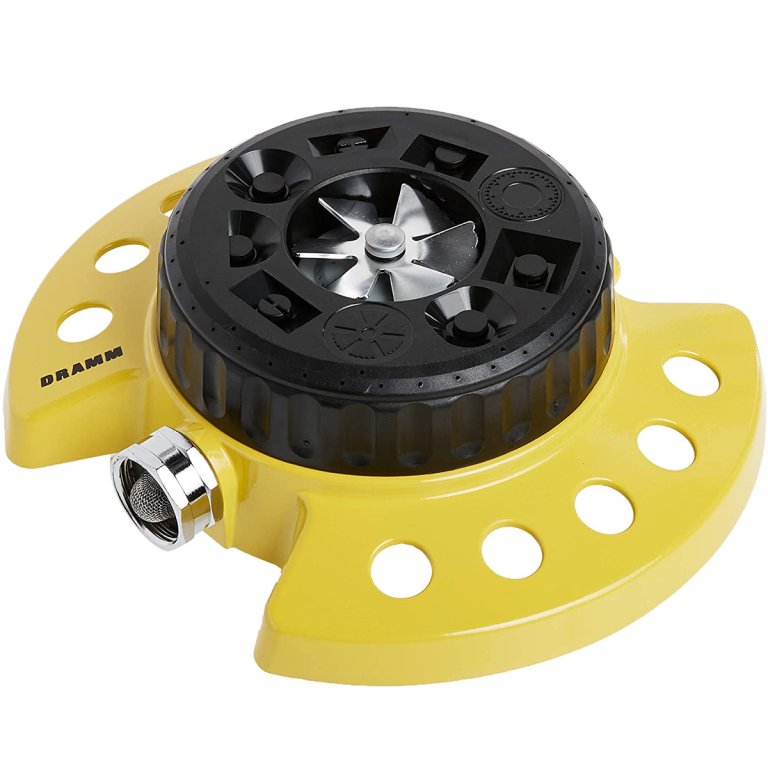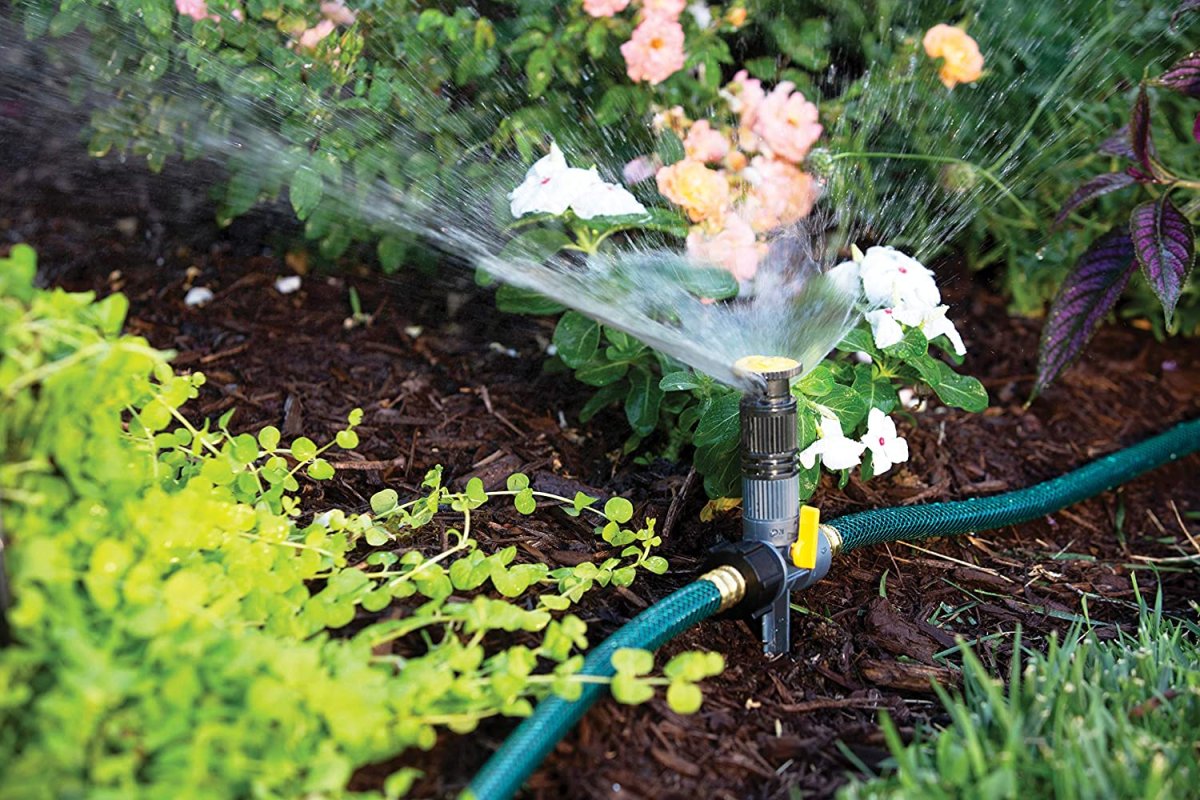
We may earn revenue from the products available on this page and participate in affiliate programs. Learn More ›
Watering the lawn and garden is easier when you replace the handheld sprayer with one or more sprinkler heads that take care of the watering for you. Some sprinkler heads even work with sprinkler controllers for a truly automatic irrigation system. More basic sprinkler heads only need to be connected to a hose and have the water turned on, making it simple to water the lawn two or three times per week for 20 to 30 minutes at a time.
Choosing the best sprinkler heads for your lawn depends on various factors, including the type of sprinkler, the size of the yard, the water pressure, and your knowledge and experience with sprinkler systems to ensure installation without leaks. Use this guide to learn what to look for in sprinkler heads and why the products below are considered among the best available.
- BEST OVERALL: Gilmour 887613-1001 Square Pattern Spot Sprinkler
- BEST POP UP: Orbit Voyager II Gear Driven Pop-Up Sprinkler Head
- BEST MISTING: DINGJIN 80 Pcs Sprinkler Irrigation System
- BEST OSCILLATING: Melnor 65003-AMZ MiniMax Turbo Oscillating Sprinkler
- BEST STATIONARY: Dramm ColorStorm 9-Pattern Premium Turret Sprinkler
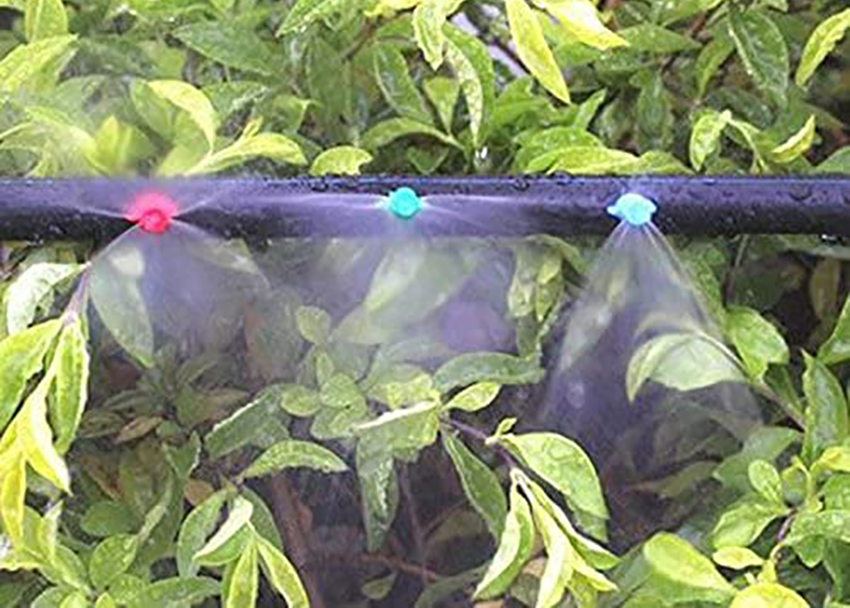
What to Consider When Choosing the Best Sprinkler Heads
When deciding on the best sprinkler heads to properly water the lawn, keep in mind that some products are straightforward and operate with only a hose connection, while others are easier to control with a smart sprinkler controller. Also read up on the following factors and features to help make the right choice.
Type
Lawn sprinkler heads fall into six general categories: fixed/stationary, oscillating, impact, rotating, misting/micro, and pop-up or in-ground.
- Fixed or stationary sprinkler heads usually have a central body and a circular nozzle that sprays water in all directions. These sprinkler heads don’t need to move to operate, though they aren’t the best option for large yards.
- Oscillating sprinkler heads typically have one or two rows of holes that spray water in a single direction. The head sits on a base and oscillates slowly from one side to the other, creating a curtain or fan of water that saturates the lawn. These heads are also fun for kids to jump through on hot days.
- Impact sprinkler heads are also known as impulse or pulsating heads because they rotate and push water out of a single jet at a high pressure. This provides the longest water distribution range, so they’re good for large lawns, but the high-pressure jet could harm delicate plants.
- Rotating sprinkler heads spin 360 degrees and usually have two or three spinning arms. The water is dispersed through the spinning arms to saturate the lawn. The arms of some models can be adjusted to change the angle of the spray.
- Misting or micro sprinkler heads are a good option if fragile or sensitive plants may be damaged by a more powerful sprinkler head. These sprinkler heads limit the flow of water to protect plants from high-pressure streams while providing the water they need.
- Pop-up or in-ground sprinkler heads are quickly becoming a popular option for home irrigation systems because after the initial setup and installation, these sprinkler heads last much longer, provide a customizable area of range, and can be connected to sprinkler controllers for automated use. The sprinkler system is installed under the ground. The sprinkler heads are then free to pop up and water the lawn before dropping back into the ground, where they’re out of the way of foot traffic and lawn mower blades.
Material
Sprinkler heads are made from either metal, plastic, or a combination of both. Each material has pros and cons that impact durability, weight, and price.
- Metal is the material traditionally used for sprinkler heads. It’s highly durable, making the sprinkler heads unlikely to break or crack. However, metal sprinkler heads are less flexible and more susceptible to leaking at moving joints than their plastic counterparts.
- Plastic is lightweight and water resistant, and the plastic joints of sprinkler heads move with less rigidity, allowing rotating sprinklers to spin freely.
- Hybrid sprinkler heads are most common in the current market because the hybrid design combines the durability of metal (for such stable parts as the body or nozzle) with the flexibility of plastic for moving parts or as a light support to facilitate the water flow and the movement of the sprinkler head.
Lawn Size
The size of the lawn is a factor in choosing the best sprinkler heads.
- Small lawns are well served with stationary sprinkler heads that cover the entire area without needing to move, rotate, or oscillate. A small number of pop-up sprinkler heads are another good option if an automated system is desired.
- Medium lawns do well with oscillating, rotating, and pop-up sprinkler heads. The oscillating and rotating sprinkler heads have a wider range than stationary sprinklers, while a medium lawn only needs to add extra pop-up sprinkler heads to cover the additional lawn.
- Large lawns can be watered with a pop-up sprinkler system if it is operated in zones or spread extensively over the lawn. An impact sprinkler head is also suited to a large lawn due to its high water pressure output.
Water Pressure
Water pressure output from the home can affect how well certain sprinkler heads work. Oscillating, rotating, impact, and pop-up models rely on water pressure as the source of power, and very low water pressure can’t supply enough power to properly move and disperse the water across the lawn. Misting and fixed sprinkler heads should function well with low water pressure because they don’t have moving parts.
Features
There’s a spectrum of sprinkler head features that can be included in the design for greater ease and convenience. These include adjustable nozzles, lawn spikes, tripods, sleds, timers, and an integrated flow control.
- Adjustable nozzles allow the direction and angle of the flow to be changed to customize the spray to suit the lawn or garden.
- Lawn spikes, tripods, and sleds are used to support sprinkler heads. A spike is driven into the ground, ensuring the sprinkler won’t tip over or blow away. Tripods typically stand between 2 and 4 feet apart to increase the range of the sprinkler head. Sleds simply support the sprinkler head as it sits on the lawn.
- Timers control when the water is turned on and off, allowing the system to run automatically.
- Integrated flow control indicates a valve on the body or frame of the sprinkler that can be used to increase or decrease water flow to a specific sprinkler head.
Installation
Adding most sprinkler heads to a lawn is usually so simple that the term “installation” is a bit of a stretch. Stationary, oscillating, impact, and rotating sprinkler heads typically sit directly on the lawn and are connected only by a hose. Misting sprinkler heads are used in conjunction with an existing sprinkler system by replacing the spray nozzle with a misting nozzle, or they can be inserted directly into the membrane of a hose to mist the lawn whenever the hose is turned on.
Pop-up sprinkler heads do require installation, but once the lines are run and the sprinkler heads are secure, with ongoing maintenance, like replacing broken sprinkler heads, this type of irrigation system lasts the longest.
Our Top Picks
The products below were chosen for quality, price, and in accordance with the criteria detailed above. Check out these selections to discover some of the best sprinkler heads to keep the lawn looking lush and green.
Best Overall
Gilmour 887613-1001 Square Pattern Spot Sprinkler
Pros
- Affordable
- Heavy-duty metal
- Simple hose attachment
- Covers a large area for a small unit
Cons
- Fine mist hard to control in the wind
Keeping a lawn properly watered needn’t cost a lot of green. This affordable stationary sprinkler head has a heavy-duty metal base that boasts impressive durability typically not found in plastic or hybrid models. This sprinkler head has a 900-square-foot spray coverage area that is suitable for small yards, gardens, and spot-watering problem areas without wasting water or overwatering the surrounding healthy lawn.
Water is forced through a circular sprinkler head with 49 spray holes arranged in a square pattern; this pattern ensures equal water dispersion on all sides. Strong water pressure isn’t required since this is a stationary model with no moving parts. And setup couldn’t be simpler: Just attach the sprinkler head to a hose and place it on the lawn.
Best Pop Up
Orbit Voyager II Gear Driven Pop-Up Sprinkler Head
Pros
- Adjustable spray coverage
- Various nozzles to choose from
- Easy to install
Cons
- Pricey
- Need a special tool for adjustments
Whether installing a new system or replacing an old one, these pop-up sprinkler heads are worth checking out. They are designed to be screwed onto the threaded plastic pipes typically used in underground sprinkler systems. This set includes 10 pop-up sprinkler heads, each one with a spray coverage radius that can be adjusted from 25 feet to 52 feet.
The sprinkler heads are compatible with major brands of gear-driven rotor sprinklers, so they can replace similar products so a whole new system doesn’t have to be installed. They’re pre-installed with a 3-gallon-per-minute nozzle and come with a key to adjust from a partial spray to 360-degree spray.
Best Misting
DINGJIN 80 Pcs Sprinkler Irrigation System
Pros
- Gentle on delicate plants
- Multiple angle heads
- Good-quality plastic
Cons
- Can get clogged easily
Protect delicate plants from the impact damage of direct water spray with this set of 80 micro-misting sprinkler heads. Each sprinkler head has a sharp plastic spigot with threads that can be used to replace damaged spray heads in an existing system. However, the sprinkler heads may be best put to use to create a misting hose when directly installed into PVC tubing, PPR tubing, or PE piping.
Each of the three colors in the set has a different spray-area degree: 20 blue heads have a 90-degree spray area, 30 green ones have a 180-degree spray area, and 30 red ones have a full 360-degree spray area. The micro misters are made of quality plastic that’s resistant to high temperatures and deformation.
Best Oscillating
Melnor 65003-AMZ MiniMax Turbo Oscillating Sprinkler
Pros
- Operates very quietly
- Fully adjustable
- Sturdy base
Cons
- Plastic parts may leak after a while
- No user manual provided
Innovation has arrived to the oscillating sprinkler head with this compact Melnor model, which has two rows of precision spray holes, eight holes in each row. Turn the sprinkler head a full 360 degrees at the base to adjust the direction of the spray and control the flow with the integrated flow control valve. The range and width of the spray can also be independently adjusted, allowing the water to be dispersed for better coverage.
A wide, sturdy sled base has a flow-through inlet valve and outlet valve to help prevent clogs. The sprinkler head has a maximum coverage area of 4,000 square feet, making it a good option for medium and large yards. It also operates in near silence—none of the constant clicking noise of an impact sprinkler to contend with.
Best Stationary
Dramm ColorStorm 9-Pattern Premium Turret Sprinkler
Pros
- Well-built from durable materials
- Long-lasting brass connectors
- Heavy and flip-resistant
- Versatile for all yard sizes
Cons
- Not ideal for low water pressure
- Cleaning inside parts is difficult
Stationary sprinkler heads should be compact, rugged, and versatile—like the Dramm sprinkler head. It can operate at up to 90 PSI, has nine different spray patterns to customize the length, width, height, shape, and force of the flow from the sprinkler. To change from one pattern to the next, just twist the black dial on the top and it will spray from the new nozzle with a maximum coverage area of 575 square feet.
Our Verdict
For a highly affordable and easy-to-use sprinkler, consider the Gilmour 887613-1001 Square Pattern Spot Sprinkler, made from heavy-duty materials and built to last. Shoppers looking for more versatility can pick up the Melnor 65003-AMZ MiniMax Turbo Oscillating Sprinkler, which can be adjusted to suit almost any watering pattern required.
How We Chose the Best Sprinkler Heads
To create our list of recommendations, we focused on providing a range of options to cover the various types of sprinkler heads available on the market. As such, we have chosen a few of our favorites from the fixed, oscillating, misting, and pop-up categories, all of which stand out from the competition in their respective areas. We also were sure to avoid products made from substandard materials, such as cheap plastic prone to breaking and leaking, and have provided our top picks from units made from high-quality metals and plastics that promise to be less disappointing.
We are aware that certain shoppers are looking for only a simple device to water the lawn, and we have provided a few of our favorite picks to meet that goal while also suggesting options for other shoppers who are looking for more feature-intense units that can be adjusted to suit their needs more precisely.
FAQs
If you still want more info on purchasing and using a sprinkler head, consider the answers to some of the most commonly asked questions about these lawn-care essentials.
Q. Can I mix and match my sprinkler heads?
You can mix different sprinkler head brands, but don’t mix and match different sprinkler head types. Each type of head has a different optimal flow rate that would be difficult to achieve without too much or too little water pressure flowing to the other sprinkler head types.
Q. How many minutes should you water your lawn?
Watering the lawn two or three times per week for 20 to 30 minutes each time should be sufficient.
Q. How often should I water my lawn?
Depending on the weather and any water conservation regulations in effect, lawns should be watered about two or three times per week on average.
Q. How do I check the water pressure of my sprinkler system?
Proper water pressure is integral for drip irrigation, sprinkling, and misting. Use a pressure gauge to check the water pressure of the sprinkler system. Attach the gauge to the outdoor faucet or hose bib that provides water to the sprinkler system, turn on the faucet, and turn off water flow to any other part of the house (including dishwashers, washing machines, sinks, toilets, and showers). The number displayed on the pressure gauge should reflect the water pressure of the sprinkler system, though individual sprinkler heads can become clogged or broken, reducing the pressure at the sprinkler head.
Q. How often should sprinkler heads be replaced?
Sprinkler heads can last between 10 and 15 years before needing to be replaced if they are of good quality and properly maintained.
Timothy Dale is a freelance writer, specializing in the home repair and construction niche. He spent his post-secondary years working in the plumbing trade, while completing degrees in English Literature and Psychology, before taking on a Project Management position that ended up lasting 10 years. Mr. Dale has worked in residential plumbing and carpentry over his time as a Project Manager and also spent a year of his career in the commercial and industrial sector.
